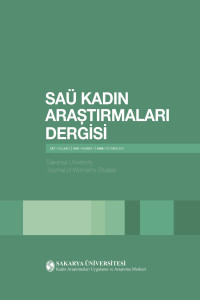Alice Walker'ın The Color Purple Adlı Eserinde Yaratıcı Bir Güç Olarak Annelik
“Alice Walker'ın The Color Purple adlı eserinde yaratıcı bir güç olarak annelik” adlı bu çalışma, anneliği feminizmin merkezine oturtarak Alice Walker'ın annelik fikirlerini analiz etmeye ve farklı kadın karakterleri, çocuk doğurmaya ya da bu ataerkil toplumda çocuk yetiştirmeye rağmen sanatsal güçlerini açığa çıkarma konusunda nasıl güçlendirdiğini anlamaya çalışıyor. Bu anne merkezli feminizm tarzı, Andrea O'Reilly tarafından ana merkezli feminizm olarak adlandırılır. Bu çalışma, The Color Purple'daki anne kategorisinin kadın kategorisinden farklı olduğu ve bu anne karakterlerin kadın ve anne olarak karşılaştıkları sorunlara rağmen sanatsal güçlerini nasıl ortaya çıkarabildikleri fikrinden hareket etmektedir. Ayrıca ana merkezli feminizm, annelik ve sanatsal güç gibi anahtar kavramlar tanımlanmıştır. Bu çalışmada kadın ve anne haklarını güçlendirmeye yönelik yeni bir feminizm dalgası olan ana merkezli feminizm tartışılmaktadır. The Color Purple'daki farklı geçmişlere sahip kadın karakterlerin analizi, anneliği feminizmin merkezine koymamızı sağlayacaktır. Makale, The Color Purple'da anneliğin güçlendirilmiş annelik, topluluk ve diğer annelik, kadın ve anne olarak karşılaştıkları sorunlara rağmen anne ve kız arasındaki ilişkinin atalarımızın anneliğiyle ilişkisi gibi çeşitli şekillerde sunulduğu ve bunun karakterlerin sanatsal güçlerini serbest bırakmalarını sağladığı sonucuna varıyor.
Motherhood as a Creative Power in Alice Walker’s The Color Purple
This study “Motherhood as a creative power in Alice Walker’s The Color Purple” attempts to analyse Alice Walker’s ideas of motherhood by putting mothering in the centre of feminism and tries to understand how it empowers different female characters to release their artistic power in spite of childbearing or childrearing in this patriarchal society. This mother-centred mode of feminism is called matricentric feminism by Andrea O’Reilly. This study is guided by the ideas that the category of mother is distinct from the category of woman in The Color Purple and how these mother characters manage to release their artistic power in spite of problems they face as women and as mothers. Besides, the key concepts such as matricentric feminism, motherhood and artistic power are defined. A new wave of feminism, matricentric feminism to empower women’s and mothers’ rights is discussed in this study. The analysis of the female characters with different backgrounds in The Color Purple will allow us to put mothering in the centre of feminism. The paper concludes that, motherhood is presented in a variety of ways, like empowered mothering, community and othermothering, the relationship between mother and daughter in relation of our foremothers’ motherhood in The Color Purple and this empowers the characters to release their artistic power in spite of problems they face as women and mothers.
Keywords:
Motherhood, feminism, women,
___
- Bloom, H., & Henderson, M. G. (1989). The Color Purple: Revisions and redefinitions. In Alice Walker; modern critical views (pp. 67–80). New York, Philadelphia: Chelsea House Publishers.
- Dieke, I., & Coleman, J. L. (1999). Revolutionary Stanzas: The civil and human rights poetry of Alice. In Critical essays on Alice Walker (pp. 83–100). Westport (Conn.), London: Greenwood Press.
- Garg, S. (2020). Concept of patriarchy and motherhood in Alice Walker’s The Color Purple. Dogo Rangsang Research Journal, 10(02).
- Green, F. J. (2019). Retrieved from https://www.routledgehandbooks.com/doi/10.4324/9781315167848-3.
- Hayasaki, E. (2017). Retrieved from https://www.theatlantic.com/science/archive/2017/09/how-motherhood-affects-creativity/539418/.
- Leitch, V. B. (2010). The Norton anthology of theory and criticism. New York: W. W. Norton and Co.
- Martin, I. (n.d.). Retrieved from https://www.studocu.com/en-gb/document/best-notes-for-high-school-gb/english-language-literature/how-is-motherhood-presented-in-the-color-purple/19200287
- O’Reilly, A. (2016). Matricentric Feminism: Theory, activism, and Practice. Bradford, Ontario: Demeter Press. Russ, J. (2005). How to suppress women’s writing? Austin: Univ. of Texas Pr.
- Simparinka, E. (2022). Feminism in Alice Walker’s The Color purple. International Journal of English Literature and Social Sciences, 7(1), 277–285. doi:10.22161/ijels.71.38
- Tucker, L. (1988). Retrieved from https://www.jstor.org/stable/2904151?googleloggedin=true
- Umansky, L. (1996). Motherhood reconceived: Feminism and the legacies of the sixties. New York: New York University Press.
- Walker, A. (2003). The Color Purple. Orlando, Fl.: Harcourt.
- Walker, A. (2004). In search of our mothers’ gardens: Womanist Prose. Orlando: Harcourt.
- Woolf, V. (2012). A room of one’s own. Mansfield Centre, CT: Martino Publishing.
- Woolf, V., & Bradshaw, D. (2009). Selected essays. Oxford: Oxford University Press.
- Başlangıç: 2022
- Yayıncı: Sakarya Üniversitesi
Sayıdaki Diğer Makaleler
Erkek Yapımı Dünya/Bizim Androsentrik Kültürümüz
Eril Gücün Kadın Bedeni Üzerindeki Tahakkümü
Türk Modernleşmesinin Cinsiyeti: Sosyal Hizmet Bağlamında Bir Değerlendirme
Peyami Safa’nın Romanlarında Doğu-Batı Karşıtlığı Bağlamında Mekânsal Ayrışma ve Kadın Şahsiyetler
Alice Walker'ın The Color Purple Adlı Eserinde Yaratıcı Bir Güç Olarak Annelik
